| Pages:
1
..
10
11
12
13
14
..
24 |
Formatik
National Hazard
   
Posts: 927
Registered: 25-3-2008
Member Is Offline
Mood: equilibrium
|
|
I stand corrected, it was monochlorourea. I didn't have time to check and verify earlier today. Dichlorourea had received recent attention also.
Beilstein Chlorharnstoff reference is 3 [I] page 35, [II] page 61. Supplements of the third volume of the 4.Auflage.
[Edited on 10-1-2010 by Formatik]
|
|
|
DJF90
International Hazard
    
Posts: 2266
Registered: 15-12-2007
Location: At the bench
Member Is Offline
Mood: No Mood
|
|
Formatik: In Chattaway's paper on dichlorourea, he states that diurea precipitates on hydrolysis with excess ammonia. My question to you (if you know
the answer) is what yield of diurea is obtained? Its got me interested...
|
|
|
franklyn
International Hazard
    
Posts: 3026
Registered: 30-5-2006
Location: Da Big Apple
Member Is Offline
Mood: No Mood
|
|
This is more in the realm of my wishful thinking, but could it really be true ?
(NH4)2SO4 + MnO2 => MnSO4•2H2O + H2NNH2
Ammonium Sulfate and Manganese Dioxide mixed in a 1 : 1 molar ratio , sealed in
a bottle that is heated in a pot of boiling brine would reform into a quantitative yield
of anhydrous Hydrazine with a precipitate of hydrated Manganese Sulfate , MnSO4•2H2O
or perhaps even a complexed adduct of both.
Some facts :
- • - Ammonium Sulfate (NH4)2SO4 decomposes at 100 °C ,
liberating Ammonia to form Ammonium Bisulfate , NH4HSO4.
- • - Ammonium Bisulfate , NH4HSO4 is acidic; pH 5.5.
- • - Manganese( IV ) Oxide , MnO2 , heated with sulfuric acid , yields Manganese( II ) Sulfate,
evolving oxygen: MnO2 + H2SO4 => MnSO4 + H2O + ½ O2
- • - pH of Manganese Sulfate MnSO4 is in the range of 3 - 3.7 , 5 - 7 for MnSO4•H2O
- • - Ammonium Bisulfate , NH4HSO4 melts on heating to 147 °C , decomposing at 280 °C
- • - Hydrazine boils at 114 °C up to 121 ºC for the azeotropic hydrate
- • - Manganese Sulfate , MnSO4 loses all water of hydration @ 400-500 ºC
it's melting Point is 700 ºC
- • - Manganese Dioxide decomposes at 535 ºC
- • - In the presence of dilute acids ( acidic salt in this case ) MnO2 is readily
attacked by strong reducing agents.
A potential problem is that such hydrazine as may form , may be oxidized
by unreacted MnO2 markedly reducing yield.
There is some precedence for this idea with copper sulfate and ammonia.
On the action of dry ammonia gas on sulfates
Chemical News & Journall of Physical Science Vol 66 , Page 223 ( 1892 ) -
http://books.google.com/books/download/Chemical_news_and_jou...
Excerpt attached below
.
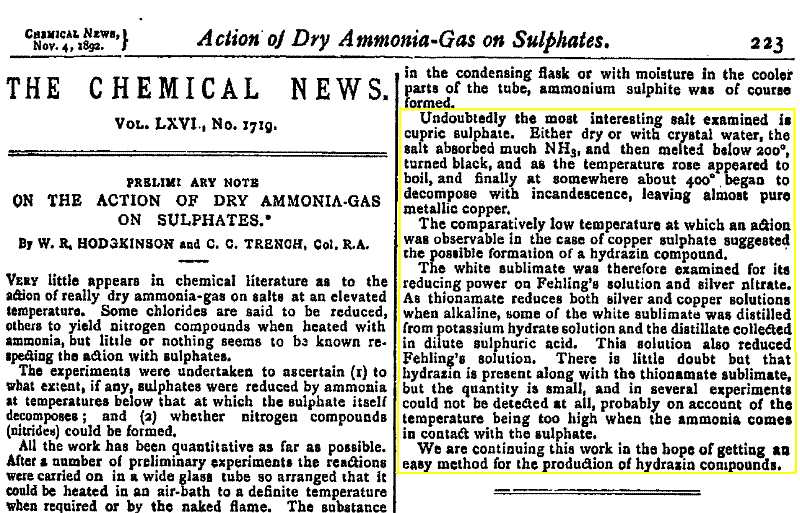
|
|
|
Taoiseach
Hazard to Others
  
Posts: 241
Registered: 16-3-2008
Member Is Offline
Mood: No Mood
|
|
Interesting idea. I once read somewhere that tetramminecopper(II)nitrate, [Cu(NH3)4](NO3)2 produces small amounts of hydrazine upon decomposition.
This would at least support the idea of sulphate/dioxide being able to oxidize NH3 to hydrazine without decomposing it at once.
Its all about getting two nitrogen atoms to bond to each other. That paves the way to azides, tetrazoles and other nitrogen-rich energetics. Its the
only reason why hydrazine is interesting to us - because it has the N-N bond, and very few reactions (especially inorganic ones!) form this bond.
|
|
|
Myfanwy
Hazard to Self
 
Posts: 68
Registered: 20-10-2009
Member Is Offline
Mood: No Mood
|
|
would be great, but i think its impossible, because metallions will cause decomposition of N2H4, especially in the heat and the reaction between
ammonium sulfate and manganese dioxide needs heat.
why not try it in a test tube. i think ammonia will given off.
|
|
|
Taoiseach
Hazard to Others
  
Posts: 241
Registered: 16-3-2008
Member Is Offline
Mood: No Mood
|
|
Nope manganese(II)sulfate is a known catalyst for the formation of hydrazine. It has been mentioned in this thread. I couldn't believe it myself at
first but I actually found a reference for this. If anyone is interested and I look hard enough around my chaotic collection of chemistry files I
might find it again 
[Edited on 30-1-2010 by Taoiseach]
|
|
|
len1
National Hazard
   
Posts: 595
Registered: 1-3-2007
Member Is Offline
Mood: NZ 1 (goal) - Italy 1 (dive)
|
|
I have a uni practical chemistry instr which also requires MnSO4.5H2O added to urea/OCl-, and no gelatine. This is bizzare as transition ions are
meant to catalyse the decomposition. And even if Mn2+ works the other way, I cant see what it can do about the Cu2+ already in solution.
And heres the final punchline - I tried the synthesis with Mn2+ and no gelatine - 0 yield!
|
|
|
Myfanwy
Hazard to Self
 
Posts: 68
Registered: 20-10-2009
Member Is Offline
Mood: No Mood
|
|
Is it dangerous to distill hydrazine(hydrate)?
Im afraid, that it could explode 
I would make it by hydrazine sulfate and an excess of sodium hydroxide.
anyway how to store hydrazine.
its very unstable on contact with oxygen in the atmosphere.
Could it decompose after some time?
And how corrosive is N2H4?
|
|
|
Myfanwy
Hazard to Self
 
Posts: 68
Registered: 20-10-2009
Member Is Offline
Mood: No Mood
|
|
oh man why so kind?
|
|
|
Myfanwy
Hazard to Self
 
Posts: 68
Registered: 20-10-2009
Member Is Offline
Mood: No Mood
|
|
i wouldnt have asked, if i had any books about hydrazine.
|
|
|
densest
Hazard to Others
  
Posts: 359
Registered: 1-10-2005
Location: in the lehr
Member Is Offline
Mood: slowly warming to strain point
|
|
Several books in electronic, downloadable form have either been posted to the forum or good links to them have been posted. Most of them are old (out
of copyright) but they do have information about distilling hydrazine (not a good idea), how to store it (as a compound), etc., etc., etc. Other
useful information is earlier in this thread and elsewhere on this site, accessible via the search feature.
|
|
|
franklyn
International Hazard
    
Posts: 3026
Registered: 30-5-2006
Location: Da Big Apple
Member Is Offline
Mood: No Mood
|
|
@ Myfanwy
You posted 3 times in 15 minutes. The forum is
similar to a community bulletin board in that it
may take several days to receive a response.
You will not experience instant gratification here.
- Asking about things so thoroughly covered
already , discloses you to be someone who cannot
so much as do a cursory search on the topic.
- If you have an interest in this subject go to the
first page of this thread and slowly look through
it to understand what you can expect to have to
do.
- You have a choice between the " Anonymous "
method or the traditional " Raschig " procedure.
- The sulfate salt is very safe compared to the
freebase which does fume.
_____________________
- Hydrazine cannot be made with (NH4)2SO4 / NaOH
You need to understand the difference between
research into unknown but plausible investigation
and elaboration of tried and tested preparations.
[Edited on 8-2-2010 by franklyn]
|
|
|
franklyn
International Hazard
    
Posts: 3026
Registered: 30-5-2006
Location: Da Big Apple
Member Is Offline
Mood: No Mood
|
|
From my post above _
" This is more in the realm of my wishful thinking, but could it really be true ?
(NH4)2SO4 + MnO2 => MnSO4•2H2O + H2NNH2
More than just partial oxidation of ammonia is necessary. I found this post
http://www.sciencemadness.org/talk/viewthread.php?tid=6777#p...
which describes that hydrogen and nitrogen result as can be expected , since no
mechanism exists to specifically form an , N - N , bond. The usual way this occurs is
with Chloramine / Ammonia metathesis thus H2NCl + NH3 => N2H4
HCl is neutralized by the hydroxyl base remain of the hypochlorite reagent.
Chloramine is unstable even cold so the prospect of a melt with hypochlorite
2 (NH4)2SO4 + Ca(ClO)2 + CaO => 2 CaSO4•2H2O + 2 N2H4•HCl
is not even possible. The essential reaction does occur thus :
(NH4)2SO4 + Ca(ClO)2 -> CaSO4•2H2O + 2 H2NCl
Suggesting a two stage procedure feeding Chloramine output into liquid ammonia.
Some prior research _
http://www.dtic.mil/srch/doc?collection=t3&id=ADA071194
.
|
|
|
Myfanwy
Hazard to Self
 
Posts: 68
Registered: 20-10-2009
Member Is Offline
Mood: No Mood
|
|
can you chlorinate urea directly with trichloroisocyanuric acid?
better then leading a stream of chlorine in it.
then just filter the (iso)cyanuric acid away.
(OCN-Cl)3 + 3H2O -> (OCN-H)3 + 3HOCl
3HOCl + 3CO(NH2)2 -> 3CONHClNH2 + 3H2O
-
(OCN-Cl)3 + 3CO(NH2)2 -> (OCN-H)3 + 3CONHClNH2
wouldnt that work?
did anyone tried that?
-----
guys i think this is the best method!okay i added about 18g Urea to 30g distilled water and dissolved some gelatin in it.
then i dissolved 31g NaOH in 30g dWater.
i added outside 20g TCCA in the urea solution. it foams up releasing very NASTY chloroamines. i hate this smell. really. i thought i must vomit.
then i filtered the solution away from the white solid.
no NCl3 was produced.
i dropped it in the Lye with 1 drop in every 2 seconds.
it foamed up producing nitrogen.
there was no chloroamine smell.
when i added 1 drop of concentrated H2SO4 it nearly exploded  . .
The reaction was somewhat exotherm and dangerous.
also there were lots of white hydrazine fumes. i had an clear fuming liquid. the smell of hydrazine was comparable with ammonia, but not that
irritating. it was a little bit sweetish.
i dilute the H2SO4 to 50% and even with that concentration it nearly explodes.
i added 100ml water to the hydrazine solution and dropped the H2SO4 in it. now it wasnt that dangerous at all.
it gets really hot and i standed in a little N2H4 cloud.
i hold on the breath (i done the whole experiment outside), because i read, that N2H4 is very corrosive to the lungs.
after the experiment i had a little pain in the lung, but now its over.
i think i added to much water. hopefully N2H6SO4 will crystallizes out.
The solution is now in the ice bath...
[Edited on 10-2-2010 by Myfanwy]
----
haha guys i love you. the best experiment i done in the whole month.
when i wrote the first part of the edit, the solution was closed in a glass, standing in an icebath.
i looked at it,but there was no crystalls.
when i opened the glass, the whole liquid became a colorless mass =D
i will now filter the crystalls and wash them with ice cold water.
i think recrystallization isnt necessary.
sorry for bad english at all.
here are some pics.
[Edited on 10-2-2010 by Myfanwy]
[Edited on 10-2-2010 by Myfanwy]
|
|
|
Myfanwy
Hazard to Self
 
Posts: 68
Registered: 20-10-2009
Member Is Offline
Mood: No Mood
|
|
okay here they are.
had to resize them..
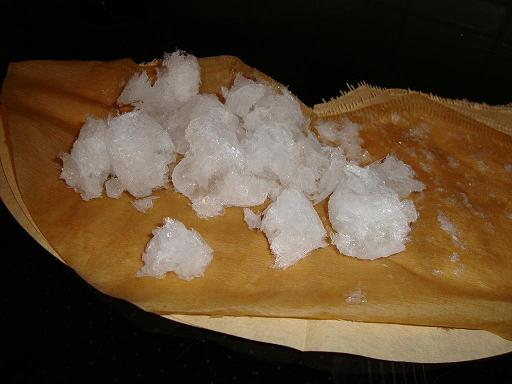
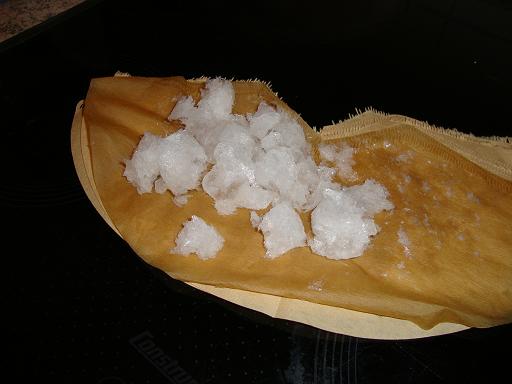
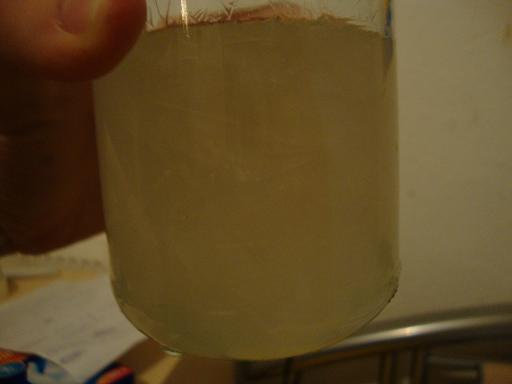
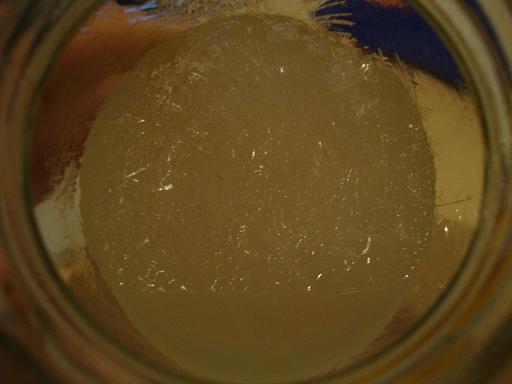
[Edited on 2-10-2010 by Polverone]
|
|
|
Polverone
Now celebrating 21 years of madness
        
Posts: 3186
Registered: 19-5-2002
Location: The Sunny Pacific Northwest
Member Is Offline
Mood: Waiting for spring
|
|
This is an interesting approach! In many places TCCA is more available, and cheaper per mol of active chlorine, than strong hypochlorite solutions.
Much to my chagrin, and amusement, in reviewing I see that I had the idea of TCCA oxidation of urea back in 2002 but neglected to ever do anything with the idea. Chris the Great tried the procedure on a
small scale in 2005, with apparent success, but had difficulty scaling it up.
TCCA does not dissolve easily in neutral aqueous solution. I am wondering if the TCCA completely dissolved/reacted in the urea solution, despite the
urea excess in your experiment.
I would be very interested if you can calculate yield of hydrazine from your experiment and validate the purity of the sulfate.
PGP Key and corresponding e-mail address
|
|
|
Taoiseach
Hazard to Others
  
Posts: 241
Registered: 16-3-2008
Member Is Offline
Mood: No Mood
|
|
I really enjoy your experimental reports Myfanwy, its always something interesting 
>when i added 1 drop of concentrated H2SO4 it nearly exploded  . .
>The reaction was somewhat exotherm and dangerous.
>also there were lots of white hydrazine fumes. i had an clear fuming liquid. the smell of hydrazine was comparable with ammonia, but not that
irritating.
>it was a little bit sweetish.
Well you get the same result when you drop conc. H2SO4 into conc. NH3 solution. Given the chemical relation between NH3 and H2N-NH2 this comes as no
suprise. I find the smell of hydrazine very hard to describe, its a tad like NH3 but less irritating and a bit like rotten fish IMHO.
>i hold on the breath (i done the whole experiment outside), because i
>read, that N2H4 is very corrosive to the lungs.
>after the experiment i had a little pain in the lung, but now its over.
Be more careful with this stuff or you could suffer serious health problems! Hydrazine is a known carcinogen.
The stuff on your pictures however doesn't look like hydrazine sulfate to me. HS forms chunky crystals, but on the pics it looks like needle shaped
crystals. You should put a little bit into a test tube and heat it. If its HS it should evaporate leaving no solid residue. When I tested my HS this
way I also smelled SO2 and the solid turned yellow for a few seconds (elementary sulfur?) until it all evaporated.
|
|
|
Myfanwy
Hazard to Self
 
Posts: 68
Registered: 20-10-2009
Member Is Offline
Mood: No Mood
|
|
yes. now the product is drying at 50°C.
i will test the purity tomorrow and scale the product.
but im sure this is hydrazine sulfate, because its bad soluble in cold water.
i tried 10 minutes ago the reaction between silver(I)-nitrate, because hydrazinium salts are good reducing agents.
i thought, that it would create an silver mirror.
and it does 
mabe i will try tomorrow, if the N2H6SO4 will produce with NaOH N2H4 and burn it.
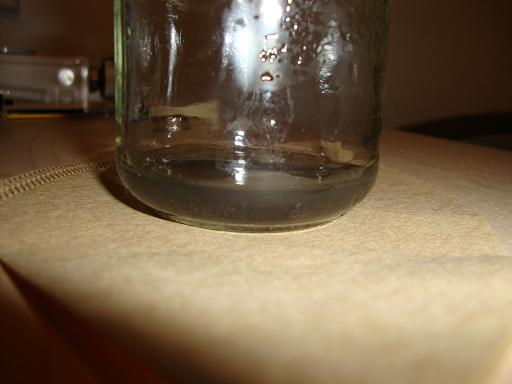
|
|
|
franklyn
International Hazard
    
Posts: 3026
Registered: 30-5-2006
Location: Da Big Apple
Member Is Offline
Mood: No Mood
|
|
b]@ Myfanwy
I compliment you on your success.
Must avoid breathing hydrazine fumes
you're doing so if you can smell it.
Stand up wind outside or have a fan
provide draft. Another solution might
be to wear a gas mask.
http://www.sciencemadness.org/talk/viewthread.php?tid=2374#p...
http://www.sciencemadness.org/talk/viewthread.php?tid=2374&a...
http://www.sciencemadness.org/talk/viewthread.php?tid=6375#p...
There are old chemists and bold chemists
but there are no old bold chemists.
.
|
|
|
len2
Harmless

Posts: 32
Registered: 13-9-2008
Member Is Offline
Mood: No Mood
|
|
| Quote: |
guys i think this is the best method!okay i added about 18g Urea to 30g distilled water and dissolved some gelatin in it.
then i dissolved 31g NaOH in 30g dWater.
i added outside 20g TCCA in the urea solution. it foams up releasing very NASTY chloroamines. i hate this smell. really. i thought i must vomit.
then i filtered the solution away from the white solid.
no NCl3 was produced.
i dropped it in the Lye with 1 drop in every 2 seconds.
it foamed up producing nitrogen.
there was no chloroamine smell.
when i added 1 drop of concentrated H2SO4 it nearly exploded  . .
The reaction was somewhat exotherm and dangerous.
also there were lots of white hydrazine fumes. i had an clear fuming liquid. the smell of hydrazine was comparable with ammonia, but not that
irritating. it was a little bit sweetish.
i dilute the H2SO4 to 50% and even with that concentration it nearly explodes.
i added 100ml water to the hydrazine solution and dropped the H2SO4 in it. now it wasnt that dangerous at all.
it gets really hot and i standed in a little N2H4 cloud.
i hold on the breath (i done the whole experiment outside), because i read, that N2H4 is very corrosive to the lungs.
after the experiment i had a little pain in the lung, but now its over.
i think i added to much water. hopefully N2H6SO4 will crystallizes out.
The solution is now in the ice bath...
|
The first step in the oxidation of urea by TCCA would be the formation of hypochlorite which then oxidizes the urea.
In the above I can not see how this can happen to any significant degree since to get TCCA to release chlorine you must use acidic conditions. That
is indeed how its release in the pool for which it is intended is governed.
Moreover if you oxidize urea in acidic conditions there will be CO2 generated with the hydrazine as you can see elementarily from the equation, the
reaction is heavily exothermic, and you get thermal runaway (this is not a guess) - this is why the degradation of urea is done in basic solution. If
this does not occur in the first stage of the above process it is only due to the paucity of Cl2 and hypochlorite available in solution. Addition of
base afterwards will only reduce the amount of Cl2 already present.
I therefore doubt the above method, both in terms of yield and the purity of product - its mostly cyanuric acid which is little soluble in water - and
another reason why the reaction can not be done this way.
[Edited on 11-2-2010 by len2]
|
|
|
franklyn
International Hazard
    
Posts: 3026
Registered: 30-5-2006
Location: Da Big Apple
Member Is Offline
Mood: No Mood
|
|
@ len2
What can be expected is not always what you get.
No reaction would not explain the following report by Myfanwy
" I added outside 20g TCCA in the urea solution. it foams up releasing very NASTY chloroamines "
" I dilute the H2SO4 to 50% and even with that concentration it nearly explodes "
Clearly there must be Na2SO4 forming and also Cyanuric , which explains the large volume of yield.
I cannot think of any competing reaction that can account for this :
" I tried 10 minutes ago the reaction between silver(I)-nitrate,
I thought, that it would create an silver mirror , and it does "
- len2
" I therefore doubt the above method, both in terms of yield and the purity of product -
its mostly cyanuric acid which is little soluble in water." -
Hydroxide will salt out Na2SO4 and Sodium Cyanurate leaving hydrazine hydrate solution
which can be further tested. Lets wait and see.
" I will try tomorrow, if the N2H6SO4 will produce with NaOH N2H4 and burn it "
.
|
|
|
Myfanwy
Hazard to Self
 
Posts: 68
Registered: 20-10-2009
Member Is Offline
Mood: No Mood
|
|
i have 27g. This is a yield of more than 80%.
cant be true...
may i should recrystallize it?
i heated an solution with this stuff with a concentrated lye and there was hydrazine produced.
but it didnt burn, i think because there was to much water vapors. but the hydrazine smell was detected.
are there some specific tests for N2H6SO4.
hydrazine can be released with a base.
and with BaCl2 BaSO4 crystallizes out.
are there some more?
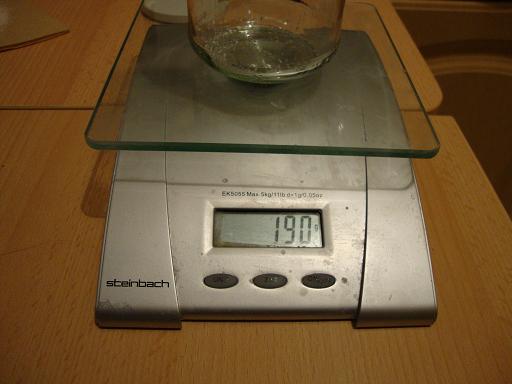 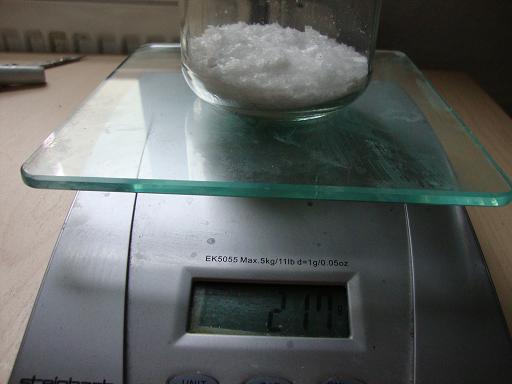 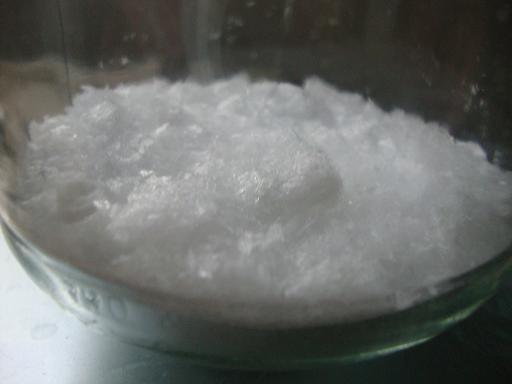
|
|
|
Taoiseach
Hazard to Others
  
Posts: 241
Registered: 16-3-2008
Member Is Offline
Mood: No Mood
|
|
>are there some more?
If you had read my post above you wouldn't ask: HEAT IT.
If it leaves anything solid, its not hydrazine sulfate (or at least not pure HS)! HS decomposes producing gaseous products only. I cant think of any
other product that could form in this reaction which also forms gasses only.
[Edited on 11-2-2010 by Taoiseach]
|
|
|
Nicodem
Super Moderator
      
Posts: 4230
Registered: 28-12-2004
Member Is Offline
Mood: No Mood
|
|
Quote: Originally posted by Myfanwy  |
are there some specific tests for N2H6SO4.
hydrazine can be released with a base.
and with BaCl2 BaSO4 crystallizes out.
are there some more? |
Perhaps the most obvious test, taking a melting point?
Quote: Originally posted by len2  | The first step in the oxidation of urea by TCCA would be the formation of hypochlorite which then oxidizes the urea.
In the above I can not see how this can happen to any significant degree since to get TCCA to release chlorine you must use acidic conditions. That
is indeed how its release in the pool for which it is intended is governed. |
TCCA is one of the most electrophilic chloroimides and it easily N-chlorinates practically any amide (sulfamides included) with a free NH position
(for literature examples see: US3850920; CA 116: 128875; or Synlett, 2005, 223-226). The yield is usually quantitative if using
acetone or similar solvents because cyanuric acid is nearly insoluble and its precipitation forwards the otherwise reversible reaction to full
conversion. I think there is no reason to believe that ureas are an exception and that monochlorourea would not form by chlorination of urea with
TCCA. In water as solvent the yield might by slightly lower than using a solvent where TCCA is soluble and cyanuric acid isn't (it is hard for all
TCCA to react when its solubility in water is nearly as low as that of cyanuric acid).
Also there is no need for acidic media for TCCA to hydrolyse to HClO. The hydrolysis equilibria constant for TCCA is 6.7×10^(-4) mol/L in water (see
Kirk-Othmer), which is indeed very low, but not prohibitively low if HClO is getting consumed while forming. Nevertheless there is no need to involve
HClO in the reaction mechanism (particularly when there is no need to do so). TCCA is just as electrophilic as HClO even if in neutral media and
probably even more so in water as solvent.
| Quote: | | Moreover if you oxidize urea in acidic conditions there will be CO2 generated with the hydrazine as you can see elementarily from the equation, the
reaction is heavily exothermic, and you get thermal runaway (this is not a guess) - this is why the degradation of urea is done in basic solution. If
this does not occur in the first stage of the above process it is only due to the paucity of Cl2 and hypochlorite available in solution. Addition of
base afterwards will only reduce the amount of Cl2 already present. |
I'm not familiar with the urea->hydrazine process, but are you sure that monochlorourea (or aqueous urea in the presence of Cl2) decomposes in
acidic media? There is an example in the literature where monochlorourea is recrystallized from acetic acid. The preparation of aqueous solution of monochlorourea in Org. Synth. uses CaCO3 to avoid basic conditions (as HCl scavenger), but then the reagent is used in
slightly acidic conditions as a source of HClO (used for making a chlorohydrin). It does not mention any problem with decomposition. I'm also having a
hard time imagining any mechanism for the formation of hydrazine from monochlorourea that would not involve bases. With bases there are at least two
available mechanisms, either Favorsky-like or Hofmann-like rearrangements (actually their "aza" variants). I find the aza-Favorsky mechanism more
likely as it would not involve any heating. In any such case the presence of a base is needed even though already just slightly basic conditions
should be enough given the relatively high NH acidity of ureas (possibly even Na2CO3 might be enough).
Edit: Forgot to mention that TCCA does not release chlorine unless reduced, for example by HCl, chlorides, sulfites, nitrites, alcohols or some other
organics, etc. It does not matter if the medium is acidic provided that the acid is nonreducing. It will utmost partially hydrolyse to HClO as
mentioned above. You can even make a solution of TCCA in conc. H2SO4 and it will not decompose. A pretty nasty solution and a source of extremely
electrophilic chlorine(I) species (this combination can perchlorinate even nitrobenzenes!). Just don't put a finger in it. 
[Edited on 11/2/2010 by Nicodem]
…there is a human touch of the cultist “believer” in every theorist that he must struggle against as being
unworthy of the scientist. Some of the greatest men of science have publicly repudiated a theory which earlier they hotly defended. In this lies their
scientific temper, not in the scientific defense of the theory. - Weston La Barre (Ghost Dance, 1972)
Read the The ScienceMadness Guidelines!
|
|
|
Myfanwy
Hazard to Self
 
Posts: 68
Registered: 20-10-2009
Member Is Offline
Mood: No Mood
|
|
taoisearch i read your post, but my burner is empty so i cant do it at this time.
taking a melting point i cant do ,too.
|
|
|
| Pages:
1
..
10
11
12
13
14
..
24 |